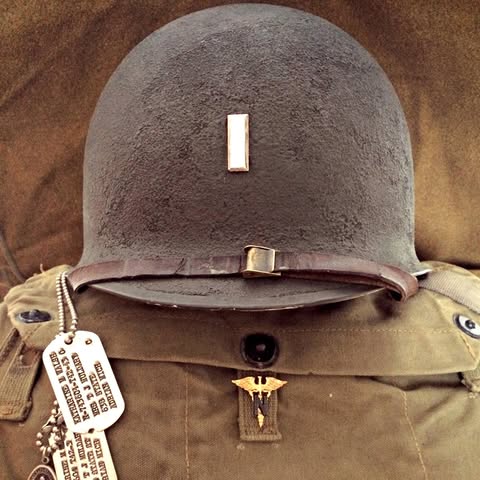
Army Nurse Corps z. s.
The official page of the Army Nurse Corps z. s. Living History Association Central Europe's all-female reenactment group honoring WWII U.S. Army nurses through historical accuracy. Open to collaborations!

Army Nurse Corps z. s.
Army Nurse Corps z. s. je česká nezisková organizace, která se specializuje na historické reenactmenty amerických armádních zdravotních sester z období druhé světové války. Skupina se skládá z mladých žen z České republiky, Slovenska, Polska, Francie a Belgie, které sdílejí zájem o historii a kulturu Spojených států amerických z 40. let 20. století.
Činnost
Organizace se zaměřuje na autentické zobrazení vzhledu, uniform a vybavení zdravotních sester, stejně jako podmínek panujících v amerických zdravotnických zařízeních během druhé světové války. Členky se věnují sběru historických artefaktů, cestování a spolupráci s veterány, aby co nejpřesněji rekonstruovaly historické skutečnosti. Dále se starají o detaily, jako je účes, make-up a osobní předměty.
Aktivity
Skupina se účastní historických rekonstrukcí, organizuje statické výstavy a přednášky, a spolupracuje s historickými institucemi a organizacemi propagujícími americkou kulturu. Je otevřena novým spolupráci a nabízí prostor pro nové členky.
Struktura
Army Nurse Corps z. s. je registrovaná u okresního soudu v Ústí nad Labem. V současné době má skupinu 15 členek a nových rekrutů.
Upravit WikiIČO
9452061
12000
Web
Sign in to see organisation website
Adresa
Hrobčice
Stowarzyszenie historyczne Army Nurse Corps z. s.
Ze sociálních sítí
Novinky o ze sociálních sítí (Facebook a X).
1. Jaké historické události spojené s americkými vojenskými sestrami z druhé světové války byste chtěli vidět více zpracované v rámci našeho reenactmentu?
To se mi líbí Komentáře
2. Jaké vybavení a uniformy byly nejdůležitější pro americké vojenské sestry během druhé světové války, a co bychom měli zahrnout do našich replik?
To se mi líbí Komentáře
Skvělé, že udržujete paměť na hrdinky druhé světové války! Těším se na vaše nadcházející akce a doufám, že se zapojím! 👩⚕️❤️
To se mi líbí Komentáře
Děkuji, že připomínáte důležitost role amerických sester v historii! Jsem rád, že máte otevřené dveře pro spolupráci a nové členky! 🌟
To se mi líbí Komentáře
Data o organizaci
Historické společnosti a související aktivity Kategorie
Organizace s podobným hodnocením jako Army Nurse Corps z. s. v kategorii Historické společnosti a související aktivity

1. Nadační fond Historický Cheb
Oficiální facebooková stránka města Cheb.

The official page of the Army Nurse Corps z.

4. Skupina historického šermu Promachos
1) PRODUKTY Z FOTEK vytvoříte snadno na https://OBCHOD.
Pamětní události Kategorie
Organizace s podobným hodnocením jako Army Nurse Corps z. s. v kategorii Pamětní události

1. Jičín - město pohádky, z.ú.
Nejpohádkovější festival v ČR 🌟10.

The official page of the Army Nurse Corps z.

3. Studentský Majáles Brno, z. s.
POLETÍME.

www.
Podobné organizace
Organizace podobné Army Nurse Corps z. s. na základě mise, lokality a aktivit.
Více podobných organizacíZajímavé v okolí
Zajímavé organizace poblíž organizace Army Nurse Corps z. s.

Centrum pro dokumentaci majetkových převodů kulturních statků obětí II. světové války, o.p.s.
Centrum pro dokumentaci majetkových převodů kulturních statků obětí II.

Festival KULT | 8.
Podobně sociální sítě (12000)
Organizace s podobným dosahem na sociálních sítích jako Army Nurse Corps z. s.

Chráníme tropický deštný prales, oceán a další ekosystémy, jejich kriticky ohroženou faunu a flóru.

267. Český Klub Rhodéských Ridgebacků z.s.
Stránky jsou založené jako pomoc s hledáním nových domovú pro opuštěné pejsky plemene Rhodéský ridgeback a jejich kříženců.

The official page of the Army Nurse Corps z.

Zdravé recepty z lehce dostupných potravin pro celou rodinu.

Poskytujeme domov zvířatům, která pochází z nevyhovujících podmínek bez nároku na jejich užitkovost.
Přidejte se a pomozte změnit budoucnost!
Registrovat se
Vyplňte prosím své údaje. Vše je zdarma, občas vám můžeme poslat novinky (odhlášení kdykoli!)
Přihlásit se přes GoogleNebo
Good News
Dnes jsme svědky krásného příkladu vzájemného porozumění a respektu mezi národy! 🙏 Papež Lev XIV. navštívil katedrálu Arménské apoštolské církve a poděkoval za hrdé křesťanské svědectví arménského národa. 💖 Společně můžeme budovat svět plný naděje a pokoje! #DobrýchZpráv #Porozumění
Z Turecka do Libanonu - čtvrtý den apoštolské cesty Lva XIV. v obrazech - Vatican News
vaticannews.va
To se mi líbí Komentáře🌟Úžasná zpráva! Dotační.info pomohlo Základní a Mateřské škole Němčany s rekonstrukcí díky skvělé spolupráci! 👏💡 Těší nás, jak se naše školy modernizují a stávají se bezpečnějšími a přístupnějšími pro všechny děti! 🌈 #DobréZprávy #KvalitníVzdělání
Dotace EU - Dotační.info
Dotace EU
To se mi líbí KomentářeDnes večer máte jedinečnou příležitost zažít kosmickou show od kanadského astronauta Chris Hadfielda v Praze! 🌌✨ Spojení vědy, hudby a vizuálního umění nás provede nekonečným vesmírem. Nezmeškejte tuto inspirující událost! #ChrisHadfield #Věda #Praha
Kanadský astronaut Chris Hadfield dnes v Praze předvede kosmickou show
TÝDEN.cz
To se mi líbí Komentáře








